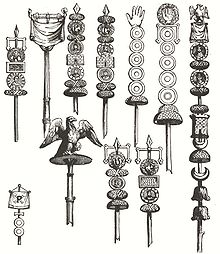This article includes a list of references, related reading, or external links, but its sources remain unclear because it lacks inline citations .(June 2024) |

Roman military standards were emblems adopted by units of the Roman army. There were three main types of standard (Aquila, Vexillum, Signum). Several throughout its history include:
- Aquila , the emblem of the Roman legion whose adoption Pliny the Elder attributes to the general Gaius Marius. Each legion had an eagle, or aquila, carried by an aquilifer;
- Vexillum , the emblem of a legion, cohors, numerus or detachments of such units. This was a flag attached to the top of the pole. One type had the name and number of the legion on it. Others were used by detachments serving away from the legion;
- Draco , a cavalry standard later adopted also by infantry units;
- Labarum , personal ensign of emperor Constantine I, later adopted as army standard.
- Signum , Each century (80 men) had its own standard, called a signum. Signa had lots of symbols attached to the pole (Many were discs with indented circles).
- Imago , Standard showed the emperor.